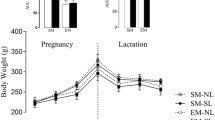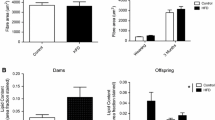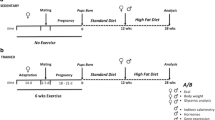Abstract
Background
Obesity is a multi-factorial condition generally attributed to an unbalanced diet and lack of exercise. Recent evidence suggests that maternal malnutrition during pregnancy and lactation can also contribute to the development of obesity in offspring. We have developed an animal model in rats to examine the effects of maternal overeating on a westernised “junk food” diet using palatable processed foods rich in fat, sugar and salt designed for human consumption. Using this model, we have shown that such a maternal diet can promote overeating and a greater preference for junk food in offspring at the end of adolescence. The maternal junk food diet also promoted adiposity and muscle atrophy at weaning. Impaired muscle development may permanently affect the function of this tissue including its ability to generate force.
Aims
The aim of this study is to determine whether a maternal junk food diet can impair muscle force generation in offspring.
Methods
Twitch and tetanic tensions were measured in offspring fed either chow alone (C) or with a junk food diet (J) during gestation, lactation and/or post-weaning up to the end of adolescence such that three groups of offspring were used, namely the CCC, JJC and JJJ groups.
Results
We show that adult offspring from mothers fed the junk food diet in pregnancy and lactation display reduced muscle force (both specific twitch and tetanic tensions) regardless of the post-weaning diet compared with offspring from mothers fed a balanced diet.
Conclusions
Maternal malnutrition can influence muscle force production in offspring which may affect an individual’s ability to exercise and thereby combat obesity.
Similar content being viewed by others
Avoid common mistakes on your manuscript.
Introduction
The rapid rise in obesity and related disorders in Western societies is generally attributed to high energy diets combined with a sedentary lifestyle. There is also new evidence to suggest that maternal malnutrition in pregnancy and lactation can influence the offspring’s propensity for developing obesity by altering appetite regulation and body composition into adult life [2, 5, 13, 14]. However, most of the focus has been on maternal under-nutrition or supplemented chow model. We have developed an animal model to examine the influence of a maternal “westernised junk food” diet using processed palatable foodstuff designed for human consumption which contain high levels of fat, sugar and salt. When given free access to this “junk food” diet together with the more nutritionally balanced rodent chow, mothers spontaneously increased their intake of energy, fat, sugar and salt but their protein intake was reduced [3]; thus this model has similarities with the low protein model used in other early life programming studies. Using this model, we have shown that such a maternal junk food diet influenced muscle development, adiposity and feeding behaviour in offspring at weaning (3 weeks post-partum) and/or at the end of adolescence (10 weeks post-partum) [3–5]. More specifically, we have shown that weanling offspring from mothers fed the junk food diet either during gestation alone, or during both gestation and lactation exhibited semitendinosus muscle atrophy with fewer muscle fibres per total muscle cross sectional area [5]. It is generally accepted that muscle fibre formation or hyperplasia normally ends around the time of birth or shortly thereafter in mammals [7, 10–12]. Therefore, if muscle development is impaired through maternal malnutrition at birth and/or at weaning, muscle fibre hypoplasia is likely to persist into adulthood [6, 15]. Skeletal muscle is the organ that enables the production of movement and force. Therefore, lasting alterations in the development of this tissue could influence its basic functions. The aim of this study is therefore to test if a maternal junk food diet in pregnancy and lactation could influence muscle force generation in offspring at the end of adolescence.
Materials and methods
Animals
All animal work was approved by the Royal Veterinary College Ethics and Welfare committee and was carried out under Home Office licence in accordance with the UK Animals (Scientific Procedures) Act 1986.
The experimental set up used in this study was based on one described in more detail previously [3]. Briefly, eight virgin female Wistar rats were mated with Wistar males (Charles River, Kent, UK). On the day a copulation plug was found, the females were isolated and given either a control (C) diet, namely RM3 chow alone (SDS Ltd, Betchworth, Surrey, UK) or a junk food diet (J), namely RM3 plus eight types of palatable processed foods including biscuits, doughnuts, cheese, potato crisps etc. A detailed description of the ingredients and nutritional information has been published elsewhere [3]. The animals were fed either the C or J diet during pregnancy, lactation and/or post-weaning up to 10 weeks of age such that three groups of offspring, namely the CCC, JJC and JJJ, were used as indicated in Table 1.
Muscle force measurements
Muscle force measurements were performed using a protocol reported previously [1]. At exactly 10 weeks post-partum, male and female offspring from the CCC, JJC and JJJ groups respectively were killed by cervical dislocation. One leg was dissected out and the muscles prepared for measurements within minutes following death. The Achilles tendon was freed and the fascia surrounding the muscles was removed such that the plantar group of muscles, namely gastrocnemius, plantaris and soleus, could contract freely upon stimulation. The proximal attachment was left attached to the tibia and distal femur. The leg was pinned to a Sylgard-coated experimental chamber and the Achilles tendon attached to a force transducer (FT03, Grass Telefactor). The muscles were perfused continuously with oxygenated Krebs solution (95% O2 and 5% CO2) at room temperature (22–25°C). Muscles were directly stimulated by an electric field generated between two silver electrodes using an isolated constant voltage stimulator (S88, Grass Telefactor). Square wave pulses of 2 ms duration and supramaximal stimulus intensities were used. The muscle length and voltage (60–70 V) were adjusted for each sample to produce the maximal twitch tension (Pt). The time to reach peak tension (contraction time, ttp) and the half relaxation time (time between maximal and half maximal tension during the relaxation phase of the twitch, t 1/2r) were determined. Tetanic contractions were elicited by stimulus trains of 500 ms duration at 10, 20, 50, 100 and 200 Hz. The maximal tetanic tension (Po) was determined from the plateau of the frequency–tension relationship. The same muscles from the opposite legs were dissected out and weighed and these measurements were used to calculate specific twitch and tetanic tensions relative to muscle weight.
Statistical analysis
Data was analysed statistically by hierarchical two-way ANOVA using the SPSS 14.0 for Windows software (SPSS Inc, Chicago, IL, USA). The fixed factors were defined as dietary “group” and “sex” while “mother” was defined as random factor. The models were set as “group”, “sex”, “group × sex” and “mother (group)” such that statistics were performed on individuals while taking sex and litter effects into account. Results showed no “group × sex” interaction therefore Tukey post-hoc tests were performed on the entire animal population combining males and females in order to further determine differences among the three nutritional groups. The residuals of the analysis were plotted to verify normal distribution and transformations were not necessary. There were five males and six females from three different mothers in the CCC group (n = 11), four males and six females from two different mothers in the JJC group (n = 10) and six males and seven females from three different mothers in the JJJ group (n = 13). Two-tailed Pearson’s correlation analyses were also performed to determine possible associations between the animals’ body weight and the maximal twitch and tetanic tensions measured. Results were considered statistically significant when P < 0.05 and as trends when 0.05 < P < 0.10.
Results and discussion
Results in Fig. 1a, c show that the maximal twitch tension was reduced in both groups exposed to the junk food diet, namely, the JJC (P < 0.01) and JJJ groups (P < 0.05) compared with the CCC group. The maximal tetanic tension (Fig. 1b, d) was reduced in the JJC group compared with both the CCC and JJJ group (P < 0.05) but the reduction in the JJJ group versus the CCC group did not reach statistical significance (P = 0.08). Figure 1c, f shows that when expressed relative to muscle mass, the specific twitch and tetanic tensions were reduced in both groups of offspring exposed to the maternal junk food diet (JJC and JJJ groups) regardless of the post-weaning diet compared with offspring never given access to junk food (CCC group) (P < 0.05 in all cases). There was also a trend towards increased specific tetanic tension in JJJ offspring compared with the JJC group (P = 0.052). The animals used in the present study were from the same batch as those used in a previous study and the influence of the dietary regimes on the offspring’s body mass has been published elsewhere [3]. Briefly, the body mass of offspring in the CCC and JJC groups were not statistically different but offspring in the JJJ group were heavier than those in both the CCC and JJC groups [3]. Two-tailed Pearson’s correlation analyses showed that there were not any significant associations between body mass and either twitch tension (P = 0.876, R = −0.021) or tetanic tension (P = 0.174, r = −0.247). Results also showed that muscle mass relative to body mass was reduced in the JJJ group (0.42 ± 0.02 g) compared with both the CCC (0.59 ± 0.01 g) and the JJC (0.56 ± 0.07 g) groups (P < 0.01 for both). Therefore, the increased maximal tetanic tension in the JJJ group compared with the JJC group (P = 0.012), with the specific tetanic tension following the same tend (P = 0.052), may be explained by the reduced muscle mass relative to body weight in this group. Increased body mass relative to muscle mass may have led the plantar muscles in the JJJ group to experience overload. This may have partially counteracted the effects of the maternal diet. This explanation is supported by a study showing that muscle overload can increase tetanic tension in the EDL muscle [8]. The contraction time to reach peak tension and the half relaxation times were unaffected by the nutritional status (data not shown). Given that overall, muscles from junk food fed offspring contracted less than the controls yet had comparable contraction/relaxation times, this may indicate signs of increased fatigability; however this needs to be investigated fully.
Maximal twitch (a, c) and tetanic tensions (b, d) in grams and mN, and specific twitch (e) and tetanic (f) tensions in N/g in the gatrocnemius, soleus, and plantaris muscles in offspring fed either a control chow (C) or junk food (J) diet in pregnancy, lactation and after weaning up to the end of adolescence. Blue CCC, red JJC, green JJJ groups. Results are mean ± SEM. Different letters indicate statistically significant differences by Hierarchical two-way-ANOVA followed by Tukey’s post-hoc test (P < 0.05), while asterisks indicate a trend namely 0.05 < P< 0.1
Conclusions
This preliminary study is the first to show that maternal malnutrition in pregnancy and lactation can affect the contractile properties of skeletal muscle in the offspring. The mechanisms involved are unclear but this could be a consequence of the reduction in maternal protein intake, changes in the offspring’s body composition and/or post-weaning growth rates [3, 5]. The relevance of these results for the animals’ exercise ability is also unclear but given that changes in muscle contractile properties in vitro have been linked to athletic performances in humans [9], the present results may indicate that weaker muscles may render the task of exercising more difficult. Therefore, the novel hypothesis that maternal malnutrition may influence the offspring’s ability to exercise and thereby to combat obesity through alterations in skeletal muscle development ought to be investigated further.
References
Amthor H, Macharia R, Navarrete R, Schuelke M, Brown SC, Otto A, Voit T, Muntoni F, Vrbova G, Partridge T, Zammit P, Bunger L, Patel K (2007) Lack of myostatin results in excessive muscle growth but impaired force generation. Proc Natl Acad Sci USA 104:1835–1840
Armitage JA, Poston L, Taylor PD (2008) Developmental origins of obesity and the metabolic syndrome: the role of maternal obesity. Front Horm Res 36:73–84
Bayol SA, Farrington SJ, Stickland NC (2007) A maternal ‘junk food’ diet in pregnancy and lactation promotes an exacerbated taste for ‘junk food’ and a greater propensity for obesity in rat offspring. Br J Nutr 98:843–851
Bayol SA, Simbi BH, Bertrand JA, Stickland NC (2008) Offspring from mothers fed a “junk food” diet in pregnancy and lactation exhibit exacerbated adiposity which is more pronounced in females. J Physiol 586(13):3219–3230
Bayol SA, Simbi BH, Stickland NC (2005) A maternal cafeteria diet during gestation and lactation promotes adiposity and impairs skeletal muscle development and metabolism in rat offspring at weaning. J Physiol 567:951–961
Bedi KS, Birzgalis AR, Mahon M, Smart JL, Wareham AC (1982) Early life undernutrition in rats. 1. Quantitative histology of skeletal muscles from underfed young and refed adult animals. Br J Nutr 47:417–431
Chiakulas JJ, Pauly JE (1965) A study of postnatal growth of skeletal muscle in the rat. Anat Rec 152:55–61
Frischknecht R, Vrbova G (1991) Adaptation of rat extensor digitorum longus to overload and increased activity. Pflugers Arch 419:319–326
Harber MP, Crane JD, Douglass MD, Weindel KD, Trappe TA, Trappe SW, Fink WF (2008) Resistance exercise reduces muscular substrates in women. Int J Sports Med 29(9):719–725
Ontell M, Dunn RF (1978) Neonatal muscle growth: a quantitative study. Am J Anat 152:539–555
Ontell M, Kozeka K (1984) Organogenesis of the mouse extensor digitorum logus muscle: a quantitative study. Am J Anat 171:149–161
Ross JJ, Duxson MJ, Harris AJ (1987) Formation of primary and secondary myotubes in rat lumbrical muscles. Development 100:383–394
Samuelsson AM, Matthews PA, Argenton M, Christie MR, McConnell JM, Jansen EH, Piersma AH, Ozanne SE, Twinn DF, Remacle C, Rowlerson A, Poston L, Taylor PD (2007) Diet-induced obesity in female mice leads to offspring hyperphagia. adiposity, hypertension, and insulin resistance. A novel murine model of developmental programming. Hypertension 51(2): 383–392
Vickers MH, Breier BH, Cutfield WS, Hofman PL, Gluckman PD (2000) Fetal origins of hyperphagia, obesity, and hypertension and postnatal amplification by hypercaloric nutrition. Am J Physiol Endocrinol Metab 279:E83–E87
Wilson SJ, Ross JJ, Harris AJ (1988) A critical period for formation of secondary myotubes defined by prenatal undernourishment in rats. Development 102:815–821
Author information
Authors and Affiliations
Corresponding author
Rights and permissions
About this article
Cite this article
Bayol, S.A., Macharia, R., Farrington, S.J. et al. Evidence that a maternal “junk food” diet during pregnancy and lactation can reduce muscle force in offspring. Eur J Nutr 48, 62–65 (2009). https://doi.org/10.1007/s00394-008-0760-5
Received:
Accepted:
Published:
Issue Date:
DOI: https://doi.org/10.1007/s00394-008-0760-5





